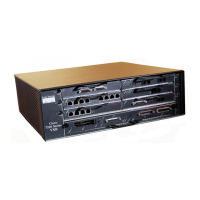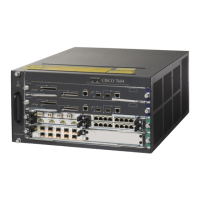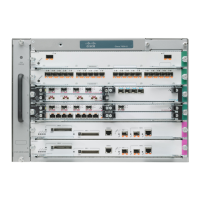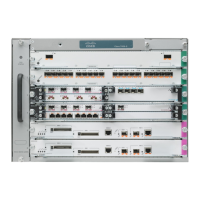1-56
Cisco uBR7200 Series Universal Broadband Router Software Configuration Guide
OL-2239-05
Chapter 1 Overview of Cisco uBR7200 Series Software
Supported Software Features for the Cisco uBR7200 Series
To change these settings, two or more traffic profiles are defined, with differing downstream QoS
settings as desired.
Table 11 provides two examples of such QoS profiles for illustration:
In this scenario, both QoS profiles are identical except for the max-ds-burst size, which is set to 5000 in
QoS profile 101 and 5000 in QoS profile 102.
Optimal Settings for DOCSIS 1.0 Downstream Powerburst
DOCSIS allows the setting different token bucket parameters for each service flow, including the token
bucket burst size. When burst sizes are closer to 0, QoS is enforced in a stricter manner, allowing a more
predictable sharing of network resources, and as a result easier network planning.
When burst sizes are larger, individual flows can transmit information faster (lower latency), although
the latency variance can be larger as well.
For individual flows, a larger burst size is likely to be better. As long as the system is not congested, a large
burst size reduces the chances of two flows transmitting at the same time, because each burst is likely to take
less time to transmit. However, as channel bandwidth consumption increases, it is probably that large burst
traffic would exceed the thresholds of buffer depths, and latency is longer than with well shaped traffic.
For additional information about the cable qos profile command and configuring QoS profiles, refer to
the following documents on Cisco.com:
• Cisco IOS CMTS Cable Command Reference Guide
http://www.cisco.com/en/US/docs/ios/cable/command/reference/cbl_book.html
• DOCSIS 1.1 for the Cisco CMTS
http://www.cisco.com/en/US/docs/cable/cmts/feature/guide/ufg_docs.html
DOCSIS 1.0+ Feature Support
In response to the limitations of DOCSIS 1.0 in handling real-time traffic, such as voice calls,
Cisco
created the DOCSIS 1.0+ extensions to provide the more important QoS enhancements that were
expected in DOCSIS 1.1. The main enhancements provide basic Voice-over IP (VoIP) service over the
DOCSIS link, support for dynamic creation and teardown of flows during voice calls, support for one
new unsolicited grant service (UGS) slot scheduling mechanism for voice slots, and per IP-precedence
rate shaping on the downstream. In particular, the Cisco
DOCSIS 1.0+ extensions include the
DOCSIS
1.1 features described in this section:
• Concatenation for DOCSIS 1.0+, page 1-57
• Dynamic MAC messages, page 1-57
• Multiple SIDs per Cable Modem, page 1-57
• Separate Downstream Rates, page 1-57
• Unsolicited Grant Service (CBR-scheduling) on the Upstream, page 1-57
Refer to the following online document for additional information about DOCSIS 1.0+ support on the
Cisco uBR7200 Series:
• Frequently Asked Questions on DOCSIS 1.0+
Ta b l e 11 Sample QoS Profiles with Differing ERBA (Maximum Downstream) Settings
QoS Profile Setting QoS Profile 101 QoS Profile 102
Maximum Downstream Transmit Burst (bytes) max-burst 4000 max-burst 4000
Maximum Downstream Burst (bps) max-ds-burst 20000 max-ds-burst 5000
Maximum Downstream Bandwidth max-downstream 100 max-downstream 100
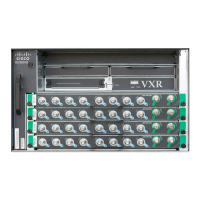
